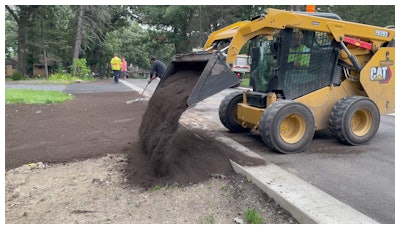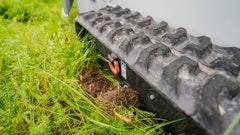
Soil health is the foundation of every successful landscape project. It influences water retention, nutrient cycling, and plant resilience. Contractors who prioritize soil structure and biology through practices such as decompaction, organic matter incorporation, and regular testing can deliver higher client satisfaction and project value over time.
By adopting a soil health management system rooted in the four principles of minimal disturbance, continuous living cover, plant diversity, and nutrient optimization, landscape professionals can achieve measurable ROI within five to ten years, often recouping up to 50 percent of initial soil remediation costs through reduced irrigation and input expenses. Integrating routine soil testing and tailored amendments enables contractors to make data-driven decisions, aligning site conditions with design intent, and ensuring long-term site success for clients and the environment alike.
Lessons from Oakwood Estates
When Oakwood Estates, a 25-acre corporate campus in suburban Denver, experienced persistent turf failure and severe runoff issues, the general contractor feared costly rework and unhappy tenants. After excavating the failing lawn areas, the contractor discovered a two-inch compacted clay layer just below the topsoil. Rather than simply re-sodding, they brought in a soil health specialist who recommended aeration, the incorporation of high-quality organic compost, and the planting of diverse cover crops over an off-season period.
Within 18 months, Oakwood’s turf established robust root systems, requiring 30 percent less irrigation and virtually eliminating erosion during spring storms. The contractor not only avoided a six-figure rework bill but also earned a long-term maintenance contract, demonstrating how proactive soil health investments pay dividends in project value and client trust.
 An SFI Topsoil truck is loaded for a dirt delivery with a conveyor in the background.SFI Topsoil
An SFI Topsoil truck is loaded for a dirt delivery with a conveyor in the background.SFI Topsoil
Key Practices for Contractors
Healthy soil functions as a living ecosystem, balancing physical structure, chemical fertility, and biological activity. Well-structured soil with adequate pore space enhances water infiltration and retention. This can greatly reduce irrigation needs and stormwater management challenges.
Optimal pH and nutrient availability supports plant vigor and reduces reliance on synthetic fertilizers, translating into lower input costs and fewer nutrient-leaching concerns. A diverse community of microorganisms drives nutrient cycling, disease suppression, and soil aggregation. These are key factors in establishing resilient landscapes capable of withstanding drought, compaction, and invasive species pressures.
- Soil testing and baseline assessment — Contractors should begin every project by conducting some form of a soil test. This can include texture analysis, organic matter content, pH, and bulk density measurements. Standardized testing protocols like those outlined by the Natural Resources Conservation Service provide actionable data to tailor amendments and compaction remediation strategies.
- Minimizing disturbance and decompaction — Maintaining existing soil structures where possible limits disruption of soil life. In compacted areas, deep-tine aeration or sub-soiling breaks the “hardpan,” improving root penetration and water movement. Such mechanical treatments often pay for themselves through reduced irrigation and maintenance costs within two growing seasons.
- Incorporating organic matter — Adding compost or other stabilized organic materials increases soil aggregate stability and water-holding capacity. Organic matter serves as a slow-release nutrient reservoir, enhancing plant uptake and microbial activity. Studies have shown that a 1 percent increase in soil organic matter can improve water retention by up to 25 percent, translating to significant irrigation savings on large sites.
- Continuous living cover and diversity — Planting cover crops or green manures during off-seasons maintains living roots in the soil, feeding microbes and protecting against erosion. Introducing a mix of legumes, grasses, and broadleaf species enhances nutrient cycling and reduces pest pressures, creating a self-sustaining soil environment.
- Nutrient management and biostimulants — Based on soil test results, contractors can apply targeted nutrient amendments to correct deficiencies. Some examples of this include precise N-P-K blends or micronutrient supplements. The strategic use of bio stimulants (e.g., mycorrhizal inoculants) further bolsters root health and improves nutrient uptake efficiency.
 An SFI Topsoil truck unloads dirt at a field.SFI Topsoil
An SFI Topsoil truck unloads dirt at a field.SFI Topsoil
Delivering Long-term Value & ROI
Investing in soil health is a long-term strategy that yields both direct and indirect financial benefits. Direct savings arise from reduced irrigation, fertilizer, and pesticide costs. Indirect gains include fewer call-backs, higher client satisfaction, and the ability to command premium service fees for performance-guaranteed installations. Quantitative analyses of soil health practices in agricultural contexts report ROI ranging from 7 to 345 percent over several years, suggesting similar opportunities exist in high-value commercial and residential landscapes when appropriately managed.
 A CAT 950m wheel loader mixes topsoil for a custom blend.SFI Topsoil
A CAT 950m wheel loader mixes topsoil for a custom blend.SFI Topsoil
Monitoring, Maintenance & Communication
Contractors should establish ongoing monitoring programs, including periodic soil testing and performance metrics (e.g., volumetric water content, turf density). Transparent reporting to clients demonstrates the value of soil health measures and facilitates proactive adjustments. Educating maintenance crews on soil biology and plant-soil interactions ensures that best practices like avoiding over-tilling and respecting moisture thresholds are upheld throughout the lifecycle of the landscape.
For landscape contractors, soil health is not an optional add-on but a core component of site success. By embracing soil testing, minimal disturbance, organic amendments, living covers, and precise nutrient management, contractors can elevate project performance, reduce lifecycle costs, and strengthen client relationships.
The initial investment in soil health translates into resilient, aesthetically pleasing landscapes that stand the test of time. Investing in soil health makes every site a showcase of sustainable value and professional excellence. In short, the dirt you use as a foundation makes a difference.




















